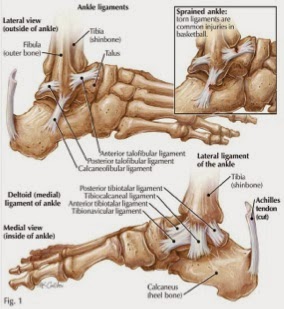Ankle sprains can be a “gateway” injury to many other injuries in the body. Read about their anatomy and proper first aid here!
Ankle Anatomy:
Ankle sprains are one of the most common injuries that occur in basketball. The ankle joint is made up primarily of three bones, the tibia (shin bone) and the fibula which comprise the outer bones of the ankle and the talus which lies between these two bones. The fibula is secured to the talus on the outside of the ankle by the anterior talofibular (ATF) ligament and to the calcaneus by the calcaneofibular (CF) ligament. The tibia is secured to the talus on the inside of the ankle by the deltoid ligament.
What is a sprain?:
When the ankle is moved beyond its limit, the ligaments stretch and potentially tear. It is most frequently injured when a player lands on another player’s foot when landing from a jump, causing the ankle to roll too far inward. This is called an inversion ankle sprain and causes an injury to the ATF ligament. Another, less common, ankle sprain is when the ankle rolls too far outward, called an eversion sprain, causing injury to the deltoid ligament.
Signs and Symptoms:
- Pain, especially with movement
- Loss of range of motion
- Swelling
- Bruising
What do I do if I sprain my ankle?
- Rest –Attempt to stay off ankle as much as possible, avoiding painful activities, for first 24-48 hours
- Ice – Ice intermittently throughout day 20 minutes at a time
- Compression – Use an ACE bandage or compression sleeve to help minimize and reduce swelling
- Elevate – Keep foot rested, preferably above heart level
What types of exercises can I do at home?
- Ankle Pumps – While elevated, pump ankle back and forth within pain tolerance to help increase range of motion and decrease swelling
- ABCs – While elevated, draw both capital and lower case letters of the alphabet
- Three way ankle (if pain free):
All of OSR’s Physical Therapists are skilled in treating sports injuries including ankle sprains. This article was submitted by Jason Kopp, ATR located in our Chanhassen office.






